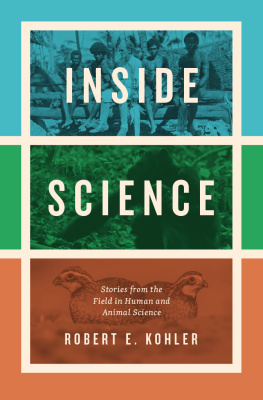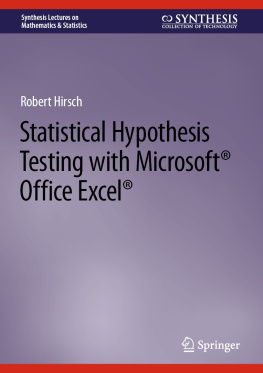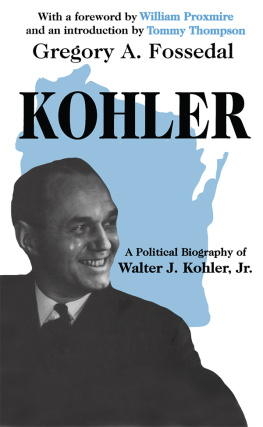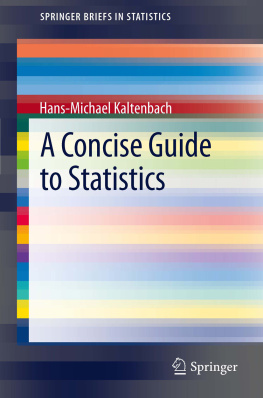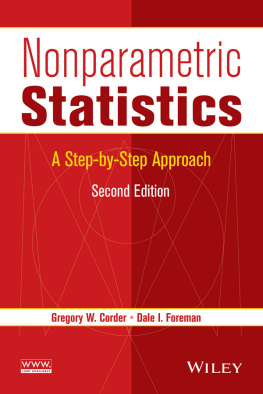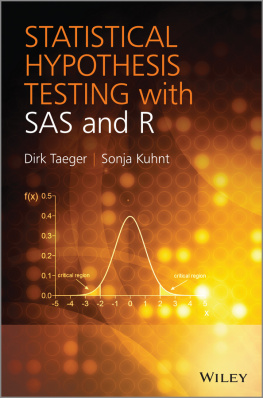STATISTICS:
A UNIVERSAL GUIDE TO THE UNKNOWN
Book 21
Hypothesis Testing:
Nonparametric Techniques
HEINZ KOHLER
Willard Long Thorp Professor of Economics, Emeritus
Amherst College
Copyright 2020 by Heinz Kohler
Contents
Foreword
The academic discipline of Statistics is a branch of mathematics that develops and uses techniques for the careful collection, effective presentation, and proper analysis of numerical information. These techniques can be applied to find answers to questions that arise in all areas of human endeavor. Medical researchers use them to test the safety and effectiveness of new drugs, devices and procedures or to appraise the effects of lifestyle changes; nutritionists use them to investigate health claims associated with foods or dietary supplements; business executives use them to assess the results of marketing campaigns or the effect of new methods of production on product quality. Economists use them to forecast the business cycle; politicians to predict the outcome of future elections. Spies use them decipher coded messages. The list goes on. No wonder that Statistics has been called a universal guide to the unknown .
The field of Statistics, however, is so vast that no single textbook can reasonably cover all of it. Nor can it anticipate which topics will be of interest to any given teacher or group of students. This author, therefore, has divided the field into 24 sections that are made available as separate books from which prospective readers can select the subset that is most useful to them. Here is a list of topics covered by this series:
Book 1: The Nature of Statistics
Book 2: Learning About Excel
Book 3: Finding Existing Data: From Print to Internet
Book 4: Generating New Data: Census Taking and Sampling
Book 5: Generating New Data: Controlled Experiments
Book 6: Presenting Data: Tables and Graphs
Book 7: Presenting Data: Summary Measures
Book 8: The Theory of Probability
Book 9: Discrete Probability Distributions
Book 10: Continuous Probability Distributions
Book 11: Sampling Distributions
Book 12: Estimation
Book 13: Hypothesis Testing: The Classical Technique
Book 14: Hypothesis Testing: The Chi-Square Technique
Book 15: Analysis of Variance
Book 16: Simple Regression and Correlation
Book 17: Multiple Regression and Correlation
Book 18: Model Building with Multiple Regression
Book 19: Time Series and Forecasting
Book 20: Index Numbers
Book 21: Hypothesis Testing Nonparametric Techniques
Book 22: Quality Control
Book 23: Decision Theory
Book 24: Issues in Medical Research
After reading this book, you will know a great deal about nonparametric tests that make no assumptions about the probability distributions of population values or about the sizes of population parameters. Among other things, you will learn to apply
the Wilcoxon rank-sum test , which seeks to determine whether the relative frequency distributions of two statistical populations are identical,
the Mann-Whitney test , an alternative to the rank-sum test that pursues the same goal and is often favored in business and economics applications,
the sign test , which examines matched-pair samples to determine whether the relative frequency distributions of two statistical populations are identical (and which can also be used to determine whether a sample comes from a population with a specified median),
the Wilcoxon signed-rank test, which, like the sign test, uses matched-pair samples to determine whether the relative frequency distributions of two statistical populations are identical, but uses more of the available sample information than the sign test,
the number-of-runs test , which determines whether the elements of a sequence appear in random order,
the Kruskal-Wallis test , which extends the Wilcoxon rank- sum test from two to more than two populations,
the Kolmogorov-Smirnov test , an alternative to the test for goodness of fit, which allows us to ascertain the nature of a population's probability distribution and can serve as a screening device for parametric tests that require a particular population distribution (often the normal distribution) in order to lead to valid results, and
the Spearman rank-correlation test , which measures the degree of association between two variables for which only rank-order data are available.
And here is a typical problem you will be able to solve:
A manufacturer advertised the median life of an aircraft spark plug as 800 service hours. The FAA doubted the claim and checked a random sample of logbooks on 50 types of planes using this type of plug. For 12 airplane types, the figure was exceeded (+), but the median service hours were lower () for the remaining 38 airplane types. Was the advertising claim correct? Conduct an appropriate hypothesis test at the 5 percent level of significance.
Preview
In 1999, a government economist wanted to compare average monthly salaries received by workers in two industries. Relevant data from two small random samples, taken independently, were available. Yet, the economist hesitated to employ the kind of hypothesis test about the difference of two means that was introduced in Book 13. The hesitation was well advised, because any hypothesis test based on the t statistic is only valid if certain conditions hold: In a two- sample test, the sampled populations must be normally distributed and must have equal variances. Salary populations, however, are almost certainly skewed to the right and not normally distributed.
At about the same time, a management-consulting firm, hired by the FAA, set out to determine whether the training given to future air traffic controllers was equally effective at four locations. The same test had been administered everywhere to the most recent air-traffic- controller class. Seven test scores were available for regions A, C, and D and six scores from region B. Yet, this analyst, too, was reluctant to employ what seemed to be the best test for the data involved: the one-way ANOVA procedure. True enough, the ANOVA F test helps us compare numerous means, but it also requires sampled populations to be normally distributed and to have equal variances. It was unclear whether such stringent assumptions could be made about the test score populations involved.
Meanwhile, a business executive had encountered a problem of her own. The firm's quality inspector had been recording the sequence of satisfactory (S) and defective (D) items coming off the assembly line, collecting data such as S, S, S, D, S, S, D, S, S... Perusing these nominal data, the executive wondered whether the appearance of defective items in the continuous production process was entirely random or whether it exhibited some kind of pattern traceable to a particular worker or machine. Yet, the executive was stumped. What kind of statistical test of such an S and D sequence could possibly answer the question raised?
The current book deals precisely with situations such as these. Unlike the classical hypothesis tests introduced in earlier books, none of this book's tests requires particular assumptions about the sampled populations or their parameters. Nor do these tests necessarily require the use of interval or ratio data. Indeed, in these nonparametric tests , the probability distributions and parameters of the sampled populations can be unknown. In addition, many of these tests can be undertaken with ordinal data or even with more primitive nominal data.
Parametric Versus Nonparametric Tests


